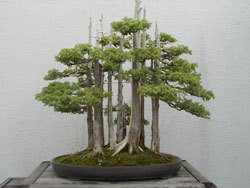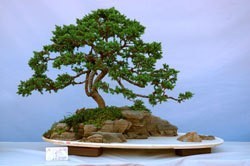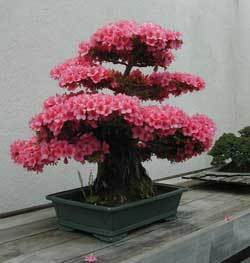
The art of Bonsai initially showed up on America's gardening radar after the Karate Kid movie trilogy in the early 1980s, when Pat Morita (a.k.a Mr. Miyagi) used a bonsai tree to teach Ralph Macchio (a.k.a Daniel Russo) the finer points of martial arts and life. In recent years, Bonsai has re-emerged as a popular pastime as people attempt to create spaces in the garden for reflection and meditation.

Roughly translated, the Japanese word bonsai (pronounced bon-sigh) means "planted in a tray." The art of bonsai is growing and training normal-sized plants to look like large, aged trees, only in miniature. The practice originated in China and was later refined in Japan. Over time, the western world has adopted this Asian horticultural tradition and today Bonsai has gained recognition as an international art form.
Bonsai plants are not genetically altered to grow to a dwarf size. And without understanding how Bonsai trees are cultured, it's easy to conclude that some kind of medieval form of gardening torture must be necessary in order to keep a full-sized tree small enough to grow in a pot. It's simply not true. The plants are not starved or forced to grow without sunlight. On the contrary, bonsai plants are given all of the same water, air, sun, and nutrients they would need to grow into full sized trees. Instead, the trees are kept small by pruning (branches and roots), repotting, pinching back new growth and training the branches to takes shape using wire. These practices are no different than many of the techniques gardeners use on other trees, shrubs, and plants in the garden.
Bonsai plants fall into two different categories: indoor and outdoor (outdoor plants making up the vast majority). It's very important to be able to distinguish between outdoor and indoor bonsai in order to choose the right plant. Many people unknowingly make the mistake of starting out with a tree suited for the outdoors, and try adapting it to living indoors (which it will never do). A short time after buying the tree it ends up dead. Assuming they are not cut out for the bonsai hobby, they simply throw in the towel and give up. If someone gives you bonsai plant as gift, make sure you find out what kind it is and if it's intended to live indoors or outdoors.
Bonsai grown indoors are usually tropical plants used to year-round warm temperatures that will adapt well to indoor conditions. These plants need full sun and should never be exposed to freezing temperatures.
Outdoor bonsai are hardy plants and trees that require seasonal change. Plants sold as outdoor bonsai typically come from temperate climates and require a winter-dormancy at near freezing temperatures. They can be kept indoors for a period of no more than a few days, because just like the trees in their native region, they become weak and die in an artificially controlled indoor environment. Outdoor bonsai species include junipers, spruces, and most of the conifers.

To see results, bonsai require years of specialized care. But if given proper care, trees can live for centuries, often much longer than their full-sized counterparts. They make wonderful living family trees. Families have been known to pass bonsai plants from one generation to the next, serving the living as a reminder of those who have passed, while allowing living relatives to add their own element of expression to the tree.
Watering: Proper watering is one of the most critical aspects of bonsai care. Trees can fool a person by looking healthy for weeks after they have died. Bonsai grown indoors should be watered every two or three days and proper care must be taken to maintain the proper humidity. Outdoor bonsai are watered according to the season-often daily in the spring, summer, and fall.
Pots and Repotting: Pots are an important aspect of bonsai. As an artistic element, people are often drawn to look at a bonsai because of the shape of the pot and the placement of the tree. To help maintain their growth, bonsai trees need to be repotted every four to fives years when the roots become pot-bound.

Pruning & Training: To get the age-old look in a miniature tree, bonsai roots and branches are periodically pruned and new growth is cut back. Branches are carefully trained with wire to give the tree an aged, twisted appearance.
There is a lot of information available on bonsai-especially online. The practice is steeped in history and tradition and it's best to do spend some time at the bookstore, library or on the web, before committing yourself to growing plants. Once you're ready to acquire a plant, find a reputable nursery and start with a species that is more suitable for beginners.
Like art, bonsai as a hobby should be subjective. Don't believe everything your read or worry about sticking to any hard and fast rules. The important thing to remember is that like all aspects of gardening, bonsai allows you the opportunity to cultivate patience, discipline and a beautiful living thing and learn new skill-all while being close to nature.
About The Author: Ellen Brown is our Green Living and Gardening Expert. Click here to ask Ellen a question! Ellen Brown is an environmental writer and photographer and the owner of Sustainable Media, an environmental media company that specializes in helping businesses and organizations promote eco-friendly products and services. Contact her on the web at http://www.sustainable-media.com
Add your voice! Click below to comment. ThriftyFun is powered by your wisdom!
I like bonsai but until I visited the North Carolina Botanical Gardens in Asheville North Carolina I had no idea how breathtaking it can be. They have a fabulous display! You can see some of it at 67.23.15.90/
Add your voice! Click below to comment. ThriftyFun is powered by your wisdom!